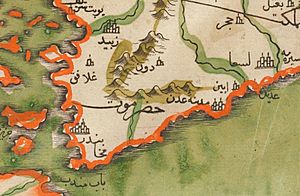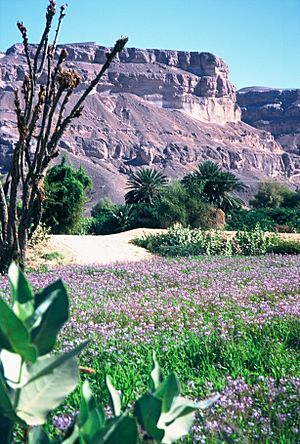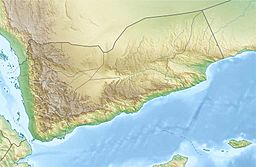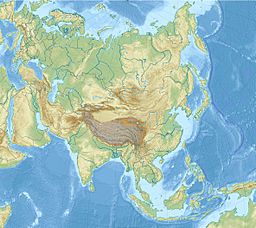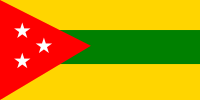Hadhramaut facts for kids
Quick facts for kids
Hadhramaut
حَضْرَمَوْتُ
حَضْرَمُوتُ Ḥaḍramawt
Ḥaḍramūt |
|
|---|---|

Buildings at the base of mountains in Wadi Hadhramaut
|
|
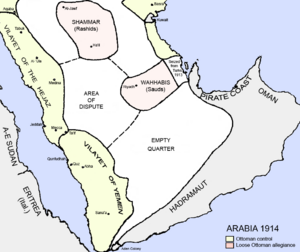
Map of the Arabian Peninsula in 1914
|
|
| Countries or territories |
|
Hadhramaut (Arabic: حَضْرَمَوْتُ \ حَضْرَمُوتُ, romanized: Ḥaḍramawt / Ḥaḍramūt) is a special region in South Arabia. It includes eastern Yemen, parts of western Oman, and southern Saudi Arabia. The name is very old. Today, a part of Yemen is still called the Hadhramaut Governorate. The people from Hadhramaut are called Hadarem. They used to speak an old language called Hadramautic. Now, most of them speak Hadhrami Arabic, which has some words from the old Hadramautic language.
Contents
Understanding the Name Hadhramaut
The exact meaning of the name Ḥaḍramawt is a bit of a mystery. There are many ideas about what it means.
Popular Stories About the Name
One popular story says the name means "death has come." This comes from two Arabic words: ḥaḍara (he came) and mawt (death). There are a few reasons people tell this story:
- Some say it was the nickname of a legendary invader named 'Amar ibn Qaḥṭān. His battles always caused many deaths.
- Another story says that after a group of people called Thamūd were destroyed, the prophet Ṣāliḥ moved here. He and about 4,000 followers died in this region. This gave the area its sad name.
- A third idea is that the name describes the ancient Hadhrami people. Their way of life was seen as very tough by nearby kingdoms.
Ancient Connections to the Name
The name Ḥaḍramawt might also be connected to the Bible. In the Bible, there's a name called Hazarmaveth. This name means "court of death," which is similar to the Arabic stories.
Other Ideas About the Name
Some experts think the name might come from a Greek word meaning "enclosed watering stations." This describes how settlements were built around water sources in the dry valleys. However, this idea is not widely accepted.
Another idea is that the name means "the green place." This makes sense because Hadhramaut has green valleys (called wadis) that stand out from the dry desert around them.
Exploring Hadhramaut's Land and Nature
Hadhramaut is a region with a special landscape. It has a narrow, dry coastal plain near the sea. Behind this plain, there's a steep cliff leading up to a wide, flat area called a plateau. This plateau is about 1,370 meters (4,500 feet) high. The plateau has deep, dry riverbeds called wadis. Water only flows in these wadis during rainy seasons. To the north, Hadhramaut slopes down into the vast Rub' al Khali desert, also known as the Empty Quarter.
The Hadhrami people live in towns built closely together. These towns are usually found near the wadis, where there is water. They grow crops like wheat and millet. They also have date palm and coconut trees. Some coffee is grown too. On the high plateau, Bedouin people raise sheep and goats.
Hadhramaut Mountains
| Hadhramaut Mountains | |
|---|---|
| Mahrat Mountains جِبَال ٱلْمَهْرَة |
|
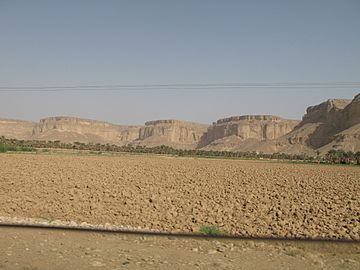
Wadi Hadhramaut
|
|
| Highest point | |
| Naming | |
| Native name | Error {{native name}}: an IETF language tag as parameter {{{1}}} is required (help) |
| Geography | |
| Country | |
| State/Province | South Arabia |
The Hadhramaut Mountains are a mountain range in Yemen. They are also called the "Mahrat Mountains." These mountains connect to the Dhofar Mountains in Oman to the northeast.
-
Al-Mukalla with the Hadhramaut in the background, seen from the Gulf of Aden
A Look at Hadhramaut's Past
Ancient Times in Hadhramaut
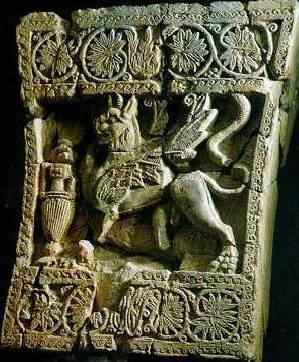
In ancient Greek writings, the Hadhrami people were called Chatramotitai. The capital city of Hadhramaut was Shabwa. It was an important place for trade, especially along the Incense Route. Shabwa was also a religious center. At first, people in Hadhramaut worshipped many gods, including the Babylonian moon god Sin. Later, by the sixth century, they started following a religion that worshipped one God.
The kingdom of Hadhramaut ended around the 3rd century AD. It was taken over by the Himyarite Kingdom.
Some early Islamic writers believed that the Kinda tribe, who formed a kingdom in central Arabia, originally came from Hadhramaut. Many prophets are also believed to have lived here, including Houd.
Modern History of Hadhramaut
From 1882 to 1967, most of Hadhramaut was ruled by the Qu'aiti sultans. They were under a loose British protectorate called the Aden Protectorate. This meant the British offered protection and advice. In 1937, the British government became "advisors" in Hadhramaut.
In 1967, the British left. Hadhramaut became part of an independent state called the People's Republic of South Yemen. Later, in 1990, South Yemen joined with North Yemen to form the Republic of Yemen.
The biggest city and capital of Hadhramaut is the port city of Mukalla. Another important historical city is Tarim. It is known as a center for Islamic learning.
Exploring the Region
Many Western explorers visited Hadhramaut. British travelers Theodore and Mabel Bent explored the area many times in the 1890s. Mabel Bent was the first European woman to visit the Wadi Hadhramaut. They wrote about their adventures in a book called Southern Arabia.
Hadhramaut's Economy
Historically, Hadhramaut was famous for producing frankincense. This was a valuable resin used in perfumes and religious ceremonies. In the early 1900s, much of it was sent to Mumbai, India. The region also produced senna (a plant used in medicine) and coconut.
Today, Hadhramaut is important for oil production. It produces about 260,000 barrels of oil every day. Oil is a huge part of Yemen's economy. It makes up 30-40% of the country's total wealth. It also provides over 70% of the government's income and more than 90% of what the country exports.
Hadhrami People Around the World
Since the early 1800s, many Hadhrami people have moved to other parts of the world. They have created large communities around the Indian Ocean. You can find Hadhrami people in places like India, Southeast Asia, and East Africa. This includes cities like Mombasa, Hyderabad, and Singapore.
In the past, some sultans (rulers) in Southeast Asia, like those in the Malacca Sultanate, were descendants of Hadhrami people. Today, some important politicians in Indonesia and East Timor also have Hadhrami family roots.
Hadhrami people also settled along the East African coast. Some former ministers in Kenya are of Hadhrami descent. There was also a Jewish population in the Hadhramaut region for a long time.
See also
- Middle East
- The Federal Region


